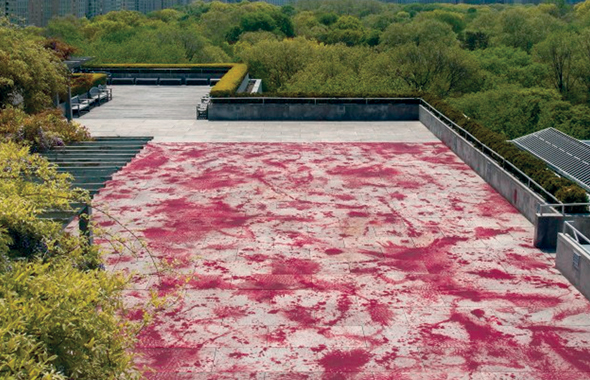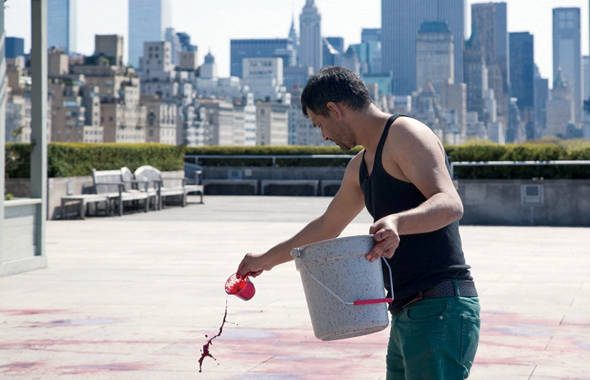Pakistani Art by Imran Qureshi Takes on NYC in MOMA’s Roof Garden Commission

The painting installation set against Central Park and the Manhattan skyline provides a stark contrast and sets a morose but hopeful atmosphere.
By Aseem Kulkarni
NEW YORK: Pakistan, one of the largest Islamic republics in the world, is continually characterized by extreme violence and poverty, religious fanaticism, conflicts with neighboring countries, and no faith in government rule. However, Pakistani artist Imran Qureshi has found a visual outlet to provide hope out of the ever present bloodshed and turmoil.
Imran Qureshi is one of the most important figures on the Pakistani art scene. The artist, who was born in 1972, lives in Lahore where he teaches at the National College of Art. In his paintings and installations, he combines the centuries-old Islamic art form of miniature painting with conceptual approaches and elements of contemporary abstract painting.

Qureshi takes a “paint dripping” approach similar to Jackson Pollock to depict an emotional response to the blood spattering in the bombings throughout Lahore.
The Metropolitan Museum in New York’s Roof Garden project represents the artist’s emotional response to violence occurring across the globe in recent decades and his earnest hope for regeneration and lasting peace in the aftermath of man-made disasters.
Three years ago Qureshi began to use red acrylic in his installations in response to brutal bombings in Lahore. While many of the world’s citizens have become accustomed to almost daily attacks on their streets, such cruelty striking so close to home provoked a deep response in his work.
Using the nearly 8,000-square-foot open-air space as his canvas, Qureshi has worked areas of his spilled and splattered red acrylic paint into patterns of lush ornamental leaves that evoke the luxuriant walled gardens that are ubiquitous in miniatures of the Mughal court; they also echo the spectacular verdant foliage of Central Park surrounding the Roof Garden today.
Qureshi is the first artist to create a work that will be painted directly onto the Roof’s surface, and visitors will be encouraged to walk on it as they view it.
“These forms stem from the effects of violence,” he explains in a statement posted by the museum. “They are mingled with the color of blood, but, at the same time, this is where a dialogue with life, with new beginnings and fresh hope starts.” Qureshi states.
The installation has met with mixed reviews and sentiments. Many view Qureshi’s painting as obvious and lackluster pointing to the question, does the work translate to a Western audience?
Even though the most recent Boston Marathon Massacre has evoked many feelings similar to the effect of September 11, to the South Asian community, whether you are from India, Pakistan, Bangladesh, etc., violence and terrorism are sadly, common occurences.
The exhibit is on view on the rooftop garden of the Metropolitan Museum of Art in New York (weather permitting) until November 3.
